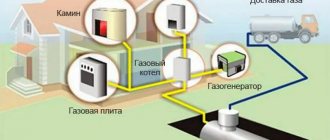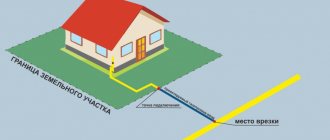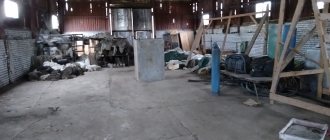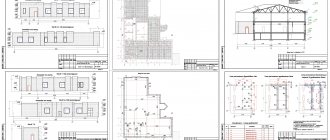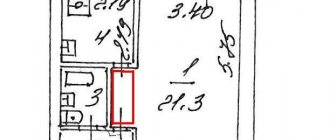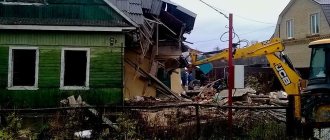What is reconstruction?
Reconstruction is the introduction of any changes to the main characteristics of a building. Let's say you made an extension to the building or decided to build a second floor. These changes are considered reconstruction and approval is required. All unapproved changes are considered illegal, since they are not included in the Unified State Register of Real Estate. This means that the actual design of the building differs from the data about it that is recorded in the register. Reconstruction of houses built on the territories of private household plots, individual housing construction, and SNT can be carried out by notification.
Registration of unauthorized reconstruction of an apartment
How to legitimize a built house
If a house is built, but is not registered in the cadastral register, it means that it is considered unauthorized, and the developer has no legal rights to it.# Real estate registration
In practice, our cadastral engineers often encounter the following cases:
- reconstruction of semi-detached houses (a plot and a building for two owners), which were built back in Soviet times. According to documents, many owners still have their property registered as an apartment. That is, the notification procedure does not apply to such objects and it is impossible to legitimize them through the administration, only through the court. Even before the process begins, our lawyers advise not to waste time, but to put the documents in order (allocate apartments into individual residential blocks and divide the land into 2 different plots). It is imperative to carry out land surveying and obtain the consent of neighbors;
- combining several apartments into one. But the owner is not always able to legitimize such reconstruction, since after making unauthorized changes, a new property was created, for which ownership rights must be obtained. You can use the premises in this form, but you will not be able to sell or perform any other legal action. Information in technical terms will differ from factual information, which will become clear when you try to register the transaction and transfer of ownership in Rosreestr.
How to get approval for reconstruction
Not all construction and repair work requires notification; some of them are not considered reconstruction. Example: you carried out a major renovation of a house, but no changes were made to its parameters, such as the facade, number of floors, which means that in this case you do not need to obtain permission for unauthorized changes. But if the planned changes are considered reconstruction, we advise you to act in accordance with the law, because this will help save effort and time. Coordinating construction work will be much easier than learning how to legalize the reconstruction of a house without permission from local authorities.
The approval procedure consists of two stages:
- Submission of notice of reconstruction. Project documentation is not required for this; it is enough to make a diagram of the SPOZUN on the notification form.
- Waiting for a positive response from the local administration. Until you have received it, no work can be carried out.
Next, two scenarios will follow:
- You receive an affirmative answer and can begin construction.
You get rejected. In this case, you can try to eliminate the reasons that led to a negative response and then submit the notification again.
Coordination of design documentation for reconstruction of a structure is not required. But the work that will be carried out must coincide with that stated. For example, it will not be possible to demolish an old house and build a new one in its place, passing it off as reconstruction. Such discrepancies will be identified, and you will have to legitimize self-construction.
After completion of construction work, you need to proceed according to the following scheme:
- Prepare a technical plan. You need to contact a cadastral engineer and conclude an agreement with him to create a technical plan for the house after reconstruction: this can be done in.
- When the technical plan is ready, you need to notify the administration about the completion of the work, attaching technical documentation.
Then you need to wait for the commission to check whether the declared work corresponds to the actual work. A site visit will be carried out, so the likelihood of successfully misinforming the administration is very low. Inconsistencies will be identified, and you will receive an order to return the building to its original form. If no violations are recorded, you will be issued a notification of compliance.
Changes made are subject to entry into the register. By law, the local administration must submit data to Rosreestr, but if you don’t want to wait, you can do it yourself or contact the Geomer Group specialists to significantly save time.
An application for work is submitted to Rosreestr, to which all four notifications are attached. 7 days after Rosreestr receives the application, changes in it are recorded, and you receive an extract from the Unified State Register of Real Estate with updated data about the house.
Free consultation
How to legitimize a house built in violation of indentations
There is a misconception that if a house is built in violation of the setbacks from the boundaries, then it cannot be registered in the cadastral register. In fact, the court can rule in favor of the owner, even if the town planning regulations are not followed. But at the same time, we must try and collect evidence - confirmation that the preservation of the building does not violate the rights, legally protected interests of other persons, and does not create a threat to the life and health of citizens.
In practice, it happens that at the time of reconstruction, only the rules were in force, which allowed an extension/superstructure, but at the time of drawing up the documentation, for example, after tens of years, it turned out that the change in the parameters of the house occurred in violation. Each case is considered individually in court.
What to do if reconstruction was carried out illegally
Facts of illegal reconstruction occur quite often. Do the changes need to be legalized or can everything be left as is?
We remind you that all illegal work and changes can lead to serious consequences, namely:
- You will receive an order to return the house to its original condition. You will have to pay for the work yourself.
- The tax on the house will be recalculated for the last three years, since the reconstruction significantly changes the parameters of the building, and accordingly its cadastral value changes. If you add an additional floor, the cadastral value increases, and the amount of tax on the house also changes upward, since it is subject to recalculation if illegal reconstruction is detected.
- It will not be possible to conduct transactions with this house. When trying to sell it or obtain collateral against it, illegal changes to the design will be quickly detected, since the actual condition of the house does not correspond to the information in the Unified State Register of Real Estate. Problems will also arise in the case of inheritance of this property, because all procedures for legitimizing changes will have to go through the heirs, otherwise they will not be able to register the property in their own name.
- There may also be problems with connecting to communications, in particular to gas, because when the parameters of the building change, the connection diagram may also change. Gas workers may order the house to be returned to its original condition or simply turn off the gas supply.
Illegal reconstruction can lead to other troubles, so we recommend avoiding risks and doing everything in accordance with the law.
If you have already made an illegal reconstruction of your house and do not know how to make these changes to the Unified State Register of Real Estate, please contact a specialist at the Cadastral Bureau - Real Estate for advice. You can make an appointment with a professional by phone
There are a lot of nuances in real estate matters, and the methods of legalization can be different: among them there is no one that would suit absolutely everyone. Your situation may be atypical and will require a special approach and expert help, so we advise you to first consult with a specialist to assess the situation.
Free consultation
Sample permit for reconstruction of a private house
Permission for reconstruction has a form established at the regional level.
The document must indicate:
- to whom the permit was issued (name of the developer, data of the citizen);
- Document Number;
- data of the authorized federal executive body, executive power of the subject or local government body that issued the permit;
- name of the capital construction project in accordance with the design documentation;
- design characteristics;
- description of the construction stage;
- Address of the object;
- validity period of the document;
- position, full name and signature of the authorized employee;
- date of issue.
The procedure for legalization
You need to be prepared for the fact that it will take time to legitimize the reconstruction, but in general, the procedure is quite simple:
- Preparation of technical plan. Before applying for legalization of changes, you need to prepare a technical plan that will display the current state of the house. Only a cadastral engineer can make technical plans for buildings. You can order this necessary technical documentation from our company.
- Submitting an application to the local administration. At this stage, the actions are the same as for regular approval. The application is written in free form, and only the owner can submit it. If the plot or real estate is in shared ownership, consent from all owners will be required. The processing time for an application is about a month, and in most cases the administration refuses.
If the application is refused, the next authority is the court. Before filing a claim, we recommend collecting the following documents:
- Coordination with Rospotrebnadzor to ensure that the house complies with sanitary standards. The nuance is that for a private house it is not necessary to carry out a sanitary and epidemiological examination, but since it is necessary to collect forensic evidence, reconstruction can be agreed upon.
- Coordination with fire supervision. It is not always possible to coordinate the reconstruction carried out with this authority. Sometimes GPN is denied. In this case, you can submit a petition to the court to appoint a fire expert, the positive conclusion of which will be an argument in your favor.
- Consent from all interested parties. All persons interested in it must give their consent to the reconstruction. They may not only be the owners or neighbors of the site, they may also require consent from the municipality or state. For example, if the house is located near linear objects of local or federal significance. In this case, you will need to contact the regulatory authorities.
- Coordination with the Federal Air Transport Agency. It is required if your home is located within a 30-kilometer zone from airports.
The necessary approvals can take a lot of time and effort. Many authorities consider the application for about a month, and there is always a risk of refusal. Our company will help you coordinate the reconstruction with regulatory authorities.
After collecting all the documents, you can apply to the district court with a claim to recognize the ownership of the unauthorized rebuilt house. At first glance, the plaintiff already has the right of ownership, but, according to the law, the OKS has been changed, which means the property is now different. The two main consequences of reconstruction could be:
- The actual creation of a new object, for example, if you made an extension to the house or built another floor.
- Improving the characteristics of the previous object.
In your statement of claim, you must explain your point of view in a motivated manner. The documents collected at the previous stage are attached to the claim.
Registration of unauthorized reconstruction of a non-residential building
If reconstruction is carried out in an industrial, commercial or non-residential building without permission, then the owner or entrepreneur is issued a fine, the developer’s activities are suspended for up to three months, and the individual and legal entity is responsible for putting into operation the building with illegal changes. Now all over Russia there are services: the Department of City Property (DGI) and the Moscow Housing Inspectorate, which use an automated program for detecting unauthorized extensions. Her job is to take satellite imagery once a year and transmit the images to the above-mentioned government agencies, where the condition of commercial and non-residential buildings is monitored. If a discrepancy between the contours of a building is detected, then representatives of municipal authorities go to the site and issue an order requiring you to demolish this building (reconstruction).
If you are planning to reconstruct a non-residential building, then our advice is to do everything in order, as when constructing a new building. The first step is to conduct research and order a reconstruction project. Next, you need to obtain permission for reconstruction, upload documents to ISOGD and put the building into operation. To carry out all reconstruction procedures in a non-residential building while saving time and money, order the services of cadastral engineers from the real estate agency GKI Nedkadastr. They also legitimize unauthorized changes, formulate a technical plan and reconstruction project, and send the necessary package of documents to Mosgosstroynadzor. After approval of the reconstruction, new information is transferred to Rosreestr. In case of refusal, you can try to legalize the changes through the court.
We will help you prepare documentation for submission to government agencies, create a geological basis, and draw up an opinion on the technical condition of the building after unauthorized reconstruction. For MKD we will create a floor plan with diagrams and drawings of non-residential premises. We will hold a meeting where the written consent of the owners (tenants) will be obtained if the object is located on the territory of a residential building. To order our services, call or fill out the feedback form on the website. We will find a solution to your real estate problems and help resolve even the most hopeless situation. You are our next client!
What to consider before filing a claim
The courts do not always take the side of the plaintiff. Compliance with several conditions will increase the likelihood of a positive court decision:
- You must have rights to the land on which the property is located. This may be the right of ownership, lifelong inheritable ownership or perpetual use. If you are a tenant, the court will most likely refuse.
- Reconstruction should not affect the safety of the home, but you need to prove this fact. Even before the trial, you can order a construction examination or you can petition for its appointment in court. Typically, pre-trial access to experts costs less.
- Reconstruction must not violate the rights of interested parties. The court may consider that you are violating the rights of your neighbors if, for example, the extension to the house borders closely on another plot. Therefore, we recommend that you coordinate such an increase in living space with your neighbors in advance. Also, a violation of rights may occur in cases where, after reconstruction, access to utilities is difficult.
- Attempts were made at pre-trial legalization. That is, you contacted the administration and received a refusal. If these measures were not taken, the likelihood of a negative court decision is higher.
✅ Fine for illegal reconstruction
By forgetting to legalize the changes, the owner risks running into sanctions from the state. Failure to obtain permission and/or notification for reconstruction is punishable by:
- Administrative fine - in connection with illegal reconstruction, applicable to your situation (Article 9.5 of the Code of Administrative Offenses of the Russian Federation). Individuals (citizens) will have to pay from 2,000 to 5,000 rubles, as well as from 500 to 1,000 rubles for lack of permission to commission.
- Criminal liability - in connection with fraud under Art. 159 of the Criminal Code of the Russian Federation, or harm to the life and health of people.
Expert opinion
Dmitry Nosikov
Lawyer. Specialization: family and housing law.
There is also demolition (dismantling) of a private house. However, first you will have to find out whether the reconstruction of the house is an unauthorized construction? If the changes pose a threat to the health of citizens, the owner of the house will be obliged to demolish the unauthorized building. If the reconstruction does not pose a threat, does not violate the interests of neighbors, meets SNiP standards and other requirements, there is a chance to legitimize it. In this case, the residential building will not be recognized as unauthorized construction.
Did you find out about your neighbor's self-construction? Read “Where and how to complain about illegal construction?”
Is it always necessary to go to court?
Litigation can be time-consuming, and additional examinations may be required at your expense to prove your case. Therefore, if possible, it is better to solve the problem of legalization administratively:
- Order a technical plan.
- Submit an application for amendments to Rosreestr.
All that remains is to wait for the decision of Rosreestr. This method is simpler than legal proceedings, but the risk of being rejected by cadastral service employees is high. If a refusal follows, legal proceedings cannot be avoided.
What are the risks of self-reconstruction?
If communications in the house are changed, new branches need to be drawn up and legality confirmed. Otherwise, such connections are considered unauthorized, they are disconnected from the general network, and the owner is issued a fine.
There are sanctions for illegal use of rebuilt objects and non-compliance with design rules:
- citizens - a fine of 2 to 5 thousand rubles;
- for official representatives - from 20 to 50 thousand rubles;
- for persons working without a patent - from 20 to 50 thousand rubles or stoppage of work for up to 90 days;
- for legal entities - 500 thousand rubles - 1 million rubles or suspension of activities for up to 90 days.
The owner continues to use the rebuilt building, does not draw up documents, since there is no prohibition in the law on such actions. The authorities go to court, which may oblige the building to be returned to its original form, or the extensions and superstructures to be demolished. In addition, transactions with such real estate cannot be carried out.
Getting permission
Do I need permission to reconstruct a private house? When planning major changes, you must know how to legalize construction. When the reconstruction of a building involves significant changes, the requirements for obtaining a permit are mandatory.
This is specified in the Civil and Urban Planning Code of the Russian Federation, as well as in regulations. Inspecting authorities act according to orders adopted by local and federal authorities.
They carry out the following procedures:
- monitor work safety;
- check compliance with sanitary standards and fire safety standards;
- inspect the correct placement of important structures and load-bearing elements;
- respect the property interests of third parties living in adjacent territories.
Some owners are interested in whether permits are issued for individual stages of reconstruction construction.
The resolution for the construction of reconstruction can be carried out:
- all construction work on the site;
- individual stages of construction work at the request of the developer (preparatory work, installation of pits, foundations or laying of communications).
Changing the number of floors
If the owner of the house plans to add an additional floor, the status of the building changes, which is reflected in the cadastral and technical documentation.
If the house has a high roof, then the owner can convert the attic into an attic, simply by insulating the room, transforming it into a living space.
If the last floor is built on the roof location, then a thorough analysis is carried out by specialists.
Permission will be issued based on data determined by:
- soil structure on the site;
- technical characteristics and structural elements of the building;
- the permissibility of erecting a structure higher than the buildings located in the area.

